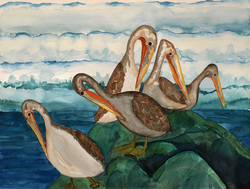Pelican Juveniles

While walking on West Cliff today, several groups of pelicans, also known as pods or squadrons, flew overhead and the varying coloration caught my eye. Some had dark breasts, some were white; then some had dark heads and others were white. I am sure it has to do with maturation as well as breeding plummage. So looking it up online, it appears that the juvenile pelicans have a dark head and a white underbelly. It takes some 3 years to be fullly mature. In adult birds the plumage plays a significant role in communication. Both sexes are alike, although males are on average slightly larger. During the breeding period, prior to nesting, the hind neck becomes vibrant dark reddish brown. In the winter or during the non-breeding period the head and neck are mainly white.
I wonder how many of you know that the brown pelican is the only pelican that dives for its food. Other pelicans scoop up their meal often after gathering together and flapping their wings to bring a school of fish into the shallows. All pelicans tilt their head back to let out the water and swallow their food right away, no storing as some might think.
They are exceptionally buoyant due to the internal air sacks beneath their skin
and in their bones, which I think is pretty interesting.
I wonder how many of you know that the brown pelican is the only pelican that dives for its food. Other pelicans scoop up their meal often after gathering together and flapping their wings to bring a school of fish into the shallows. All pelicans tilt their head back to let out the water and swallow their food right away, no storing as some might think.
They are exceptionally buoyant due to the internal air sacks beneath their skin
and in their bones, which I think is pretty interesting.

 RSS Feed
RSS Feed
